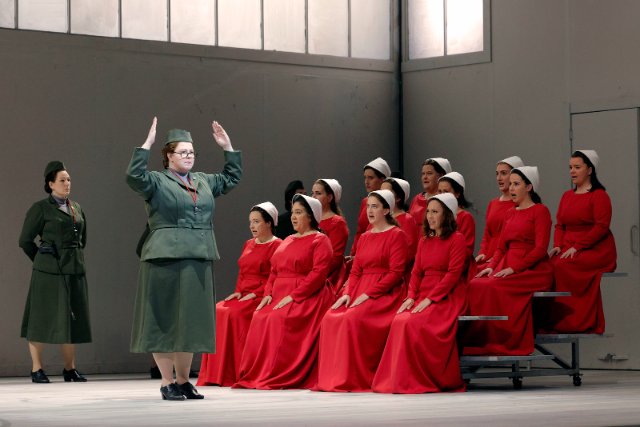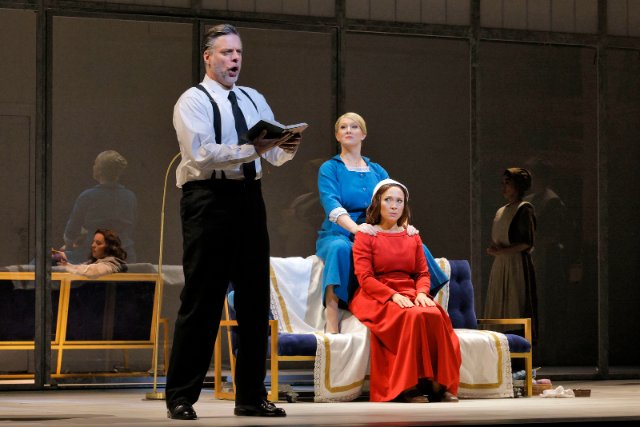The Handmaid's Tale
San Francisco Opera's Powerful Look at Socio-political Dystopia
By: Victor Cordell - Sep 19, 2024
Those of us with any literary bent who have spent most of our lives in the 20th century will be familiar with the theme of political dystopia. Among the notable works and their distinguished authors to deal with the subject are It Couldn’t Happen Here (1935) by Sinclair Lewis; Animal Farm (1945) and 1984 (1949) by George Orwell; and The Handmaid’s Tale (1985) by Margaret Atwood. These works provoke intellectual contemplation and elicit caution, but we Americans were convinced that “it couldn’t happen here.”
Events of recent years suggest otherwise – movements to have state governments dictate women’s reproductive behavior; to fund parochial schools with tax dollars; to force the Bible into public school curriculum; to ban books; to threaten political opponents with incarceration; to stifle voting rights from one part of the political spectrum; and to institutionalize lying in a Machiavellian manner all lead down the totalitarian path presciently predictive by these authors.
San Francisco Opera takes on this seldom produced but highly intense work which debuted in 2000 at a particularly poignant time in our nation’s history. Its rendering exudes artistic excellence in the production of the complex music; conquering the challenging vocal tract; and depicting the austere regimentation of the dystopian world. That said, not everyone will appreciate it. The narrative crushes the spirit without significant relief, making the storyline a cultural experience valued for its provocation and learning rather than for pleasure. The music ably reflects the story, and it does provide interest.
The oft adapted The Handmaid’s Tale chills with its societal strictures, philosophically based on the notion of “freedom from…” rather than our cherished “freedom to...” Set in the near future, the nation of Gilead has replaced the United States, as Christian fundamentalists overpowered the elected government and replaced civil rights with pernicious patriarchy and rules derived from The Ten Commandments, a veritable corollary to the Taliban.
The rigidity of society is evidenced in the staging with its visual austerity and regularity. The set largely appears in two dimensions with a dominance of straight lines and right angles, with an absence of capricious humanity. Several classes of denizens wear specified garb to comply with regulations. The titular handmaids, who function as mobile wombs to breed babies for infertile wives, are dressed in red with white caps or winged cornettes as headpieces. In the misogynistic society, their members are named after their current master, the central character being Offred, i.e., the sexual slave “of Fred.”
Poul Ruders’s weighty music conforms with the abrasiveness of the society and helps maintain suspense. Its modernist form is largely atonal and mostly harsh. Dissonance often derives from clashing musical lines that run simultaneously and disharmoniously. The building of saturated sound to crescendos and the frequent thumping of bass drums from the five percussionists (!) in the orchestra produce tension, while other (literal) bells and whistles add to the effect. Slight musical relief comes from periodic religious themes, including phrases from “Amazing Grace” and a lighter touch at the brothel that services men from the upper reaches. Conductor Karen Kamensek does a fine job of orchestrating the extremely complex score which requires two heavy tomes to explicate.
Mezzo-soprano Irene Roberts is Offred, who, like many handmaids, was trapped into duty and would like to escape, knowing that failure to produce children or violating rules can lead to being sent to the “colonies” or to execution. A recurring visual is the appearance of women who have been hanged, as a constant reminder of consequences of misdeeds.
Roberts carries a big load but with commensurate skill. The singing style is dramatic, and taxing to her voice and listener’s ear. She does have a couple of arias, but the closest vocal to being mellifluous is a fantasy set piece in a close harmony duet that she sings with “herself” – that is, her representation from “the time before” her being captured. In flashbacks, pre-and-post coup characterizations of the same individual often occur at the same time.
The other noteworthy vocals belong to Sarah Cambidge as Aunt Lydia, aunts being militaristic authority figures. She runs the Red Centre, which is the training ground for handmaids. In the prologue, Cambidge is challenged to significant and shrill singing with a tessitura high in the soprano range, which she accomplishes with great skill.
Opera audiences are pretty inured to occasional death and destruction, but The Handmaid’s Tale contains an abundance of many forms of violence plus almost constant repression. And what other opera acts as such a salient cautionary tale?
The Handmaid’s Tale, composed by Poul Ruders with libretto by Paul Bentley and based on the novel of the same name by Margaret Atwood, is produced by San Francisco Opera and plays at War Memorial Opera House at 301 Van Ness Ave., San Francisco, CA through October 1, 2024.






